Physical Address
304 North Cardinal St.
Dorchester Center, MA 02124
Estimates of fecal incontinence range from 11% to 20% of community-dwelling women older than 64 years. More than 30% of women reporting urinary incontinence also report fecal incontinence, known as dual incontinence.
The internal anal sphincter, under autonomic control, maintains the high-pressure zone or continence zone, whereas the external anal sphincter (EAS) provides the voluntary squeeze pressure that prevents incontinence with increasing rectal or abdominal pressure. The EAS is innervated by the hemorrhoidal branch of the pudendal nerve from the S2-S4 nerve roots.
A common cause of fecal incontinence is damage to the anal sphincter at the time of vaginal delivery, with or without neuronal injury. Prevention of these injuries is critical. The incidence of occult external anal sphincter disruption after vaginal delivery determined by endoanal ultrasound ranges from 11% to 35%. The chance of muscular injury is increased with midline episiotomy, instrumented delivery, and vaginal delivery of larger infants.
Approximately 1 in 10 women will develop some fecal incontinence or fecal urgency after one vaginal delivery.
Conservative treatments of fecal incontinence can help. Biofeedback for women with FI shows a similar reduction in incontinence episodes after intense education with a nurse specialist on the subjects of bowel care, medications, and dietary and fluid management. This highlights the importance of conservative management techniques. Additionally, for women with dual incontinence, this single therapy may improve both conditions. Fiber, laxatives, and antimotility medications can be recommended as effective treatment options for FI.
Overlapping anterior anal sphincteroplasty provides symptomatic control of incontinence in 60% to 80% of women initially, but long-term outcomes are not nearly as successful. According to the American College of Colorectal and Anal Surgeons, sacral neuromodulation is a first-line surgical treatment for women with or without sphincter disruption.
Anal incontinence is a common, distressing condition. Anal incontinence is a general term that refers to loss of gas or fecal material via the anus, whereas fecal incontinence (FI) is the inability to prevent loss of stool from the anus until desired. Women are often reluctant to discuss this problem with their physician because of embarrassment. Accidental bowel leakage is a newer term being used and may be a more acceptable term to women. Obstetrician-gynecologists are often the first provider a woman sees because of the contribution of pregnancy and delivery to the development of FI. Prevalence also increases with age, with nearly 1 in 5 U.S. women 65 and older suffering from anal incontinence at an estimated pretreatment cost of approximately $300 per year ( ). As women age, FI becomes the second leading cause of nursing home placement. Because of the significant effects that these disorders can have on a woman’s self-sufficiency and ability to carry out activities of daily living, it is imperative that physicians are equipped to screen and address these problems for women. This chapter addresses the causes, diagnosis, and treatment of FI.
FI is one of the most devastating of all physical disabilities, but most women fail to report their symptoms and many physicians do not ask. For example, a study of primary care physicians found that 75% screened for urinary incontinence but only 35% for FI, even though more than 30% of women reporting urinary incontinence also report FI (known as dual incontinence). Prevalence estimates range from 9% to 16% of community-dwelling women with an average age of onset between 47 and 55 years. Although little is known about racial differences, a 2010 study found a prevalence of 6.1% in noninstitutionalized African Americans aged 52 to 68 years. Approximately 10% of women will report some change in bowel habits after one vaginal delivery, but late-onset FI may have a different set of risk factors. For example, in one case-control study, bowel disturbances were a more important contributor to FI than obstetric events. Box 22.1 lists common risk factors.
General
Aging
Current smoking
Obesity
Obstetric/gynecologic
Obstetric anal sphincter laceration
Midline episiotomy
Operative vaginal delivery with forceps
Rectocele
Urinary incontinence
Gastrointestinal bowel motility disorders
Irritable bowel syndrome
Diarrhea
Fecal impaction
Hemorrhoids
Medical
Neuropathy, including diabetes
Dementia
Pelvic radiation
Medication side effects
Dietary
Surgical
Hemorrhoidectomy
Cholecystectomy
Bariatric surgery
Anorectal surgery
FI can be subdivided into three groups:
Fecal urge incontinence
Passive incontinence
Fecal seepage
Fecal urge incontinence is the loss of fecal contents despite attempts to avoid defecation. Passive incontinence refers to the involuntary discharge of feces without awareness or sensation. Fecal seepage is most often defined as the involuntary leakage of small amounts of stool.
FI affects each woman’s life in a different manner. What may be acceptable for one woman may be intolerable to another. During a woman’s evaluation it is important to understand her symptoms, type of loss (i.e., flatus or liquid/solid stool), frequency of incontinence, impact on quality of life, and concurrent pelvic floor derangements. Evaluation and treatment should be directed by the severity of the woman’s symptoms and the expected goals of therapy.
Fecal continence is a complex physiologic process that requires a person’s ability to perceive the type of fecal bolus, store or retain when necessary, and excrete when desirable. Continence is affected by the following:
Stool consistency and volume
Colonic transit time
Rectal compliance
Innervation of the pelvic floor and anal sphincter
The interplay among the puborectalis muscle, rectum, and anal sphincters.
Dysfunction of one or more of these components can lead to FI ( Table 22.1 ).
| Component | Function | Symptoms of Deficit |
|---|---|---|
| External anal sphincter | Provides emergency control for liquid stool and flatus | Fecal urgency; urge-related incontinence of liquid stool and flatus |
| Puborectalis | Maintains continence of solid stool | Incontinence of solid stool |
| Internal anal sphincter | Keeps anal canal closed at rest; allows sampling of stool content and enhances continence of liquid stool and flatus | Fecal soiling Incontinence of liquid stool and flatus |
| Anal sensation | Allows discrimination of gas, liquid, and solid stool; provides warning of impending incontinence | Fecal soiling; fecal leakage that is promptly halted by voluntary contraction on conscious detection |
| Colonic motility | Controls stool volume, consistency, and delivery rate to the rectum | Incontinence of liquid or loose stools during prolonged or severe diarrheal states |
| Rectal reservoir | Maintains adequate reservoir under low pressure | Incontinence of solid stool associated with sudden rectal distention; fecal urgency and urge-related incontinence |
As a bolus of stool and/or gas passes from the sigmoid colon to the rectal canal, receptors in the wall of the puborectalis sense the distention of the rectum. As long as the pressure in the anal canal is maintained at a higher level than the rectal pressure, continence is maintained. Anal canal pressure depends on a competent internal and external anal sphincter (IAS and EAS). The IAS, under autonomic control, is a thickened continuation of the circular muscle of the colon and provides 75% to 85% of the resting tone of the anal canal high-pressure zone. The EAS, innervated by the hemorrhoidal branch of the pudendal nerve from the S2-S4 nerve roots, provides the voluntary squeeze pressure that prevents incontinence with increasing rectal or abdominal pressure. The shape of the combined IAS and EAS is almost cylindrical, encircling and keeping the anal canal closed. Magnetic resonance imaging (MRI) scans from nulliparous women have shown that the EAS also has lateral winged projections, but their function is not understood. The sphincter complex averages 18.3 mm in thickness and 2.8 cm in length in the midline anteriorly; 54% of the anterior thickness is attributable to the IAS and the remainder to the EAS. Contraction of the EAS increases the anal canal pressure by approximately 25%, but this tone cannot be maintained indefinitely because these are fatigable, fast-twitch muscles. Disruption or dysfunction of the IAS may lead to passive incontinence, whereas dysfunction of the EAS typically results in fecal urge incontinence.
The third muscular component of the sphincter complex is the puborectalis muscle, which is innervated by direct branches from S3 and S4 and, to a lesser degree, the pudendal nerve ( Fig. 22.1 ). The puborectalis, part of the levator ani muscle complex, originates from the pubic bone on either side of the midline, passes beside the vagina and rectum, and fuses posteriorly behind the anorectal junction to form a U-shaped sling that cradles the rectum. Like the IAS, the puborectalis maintains a constant muscle tone proportional to the volume of the rectal contents and pressure and relaxes for defecation. The puborectalis and EAS are primarily type I, or slow-twitch, muscle fibers ideally suited for maintaining a constant contraction or tone. The small proportion of type II, or fast-twitch, fibers allows for quick responses to rapid increases in intraabdominal pressure such as coughing or sneezing. The constant contraction of the puborectalis creates a roughly 90-degree angle, known as the anorectal angle, between the rectum and anal canal. The role of this angle and potentially pathologic changes to it in the maintenance and failure of continence has long been debated; however, no conclusions have been reached ( Fig. 22.2 ).
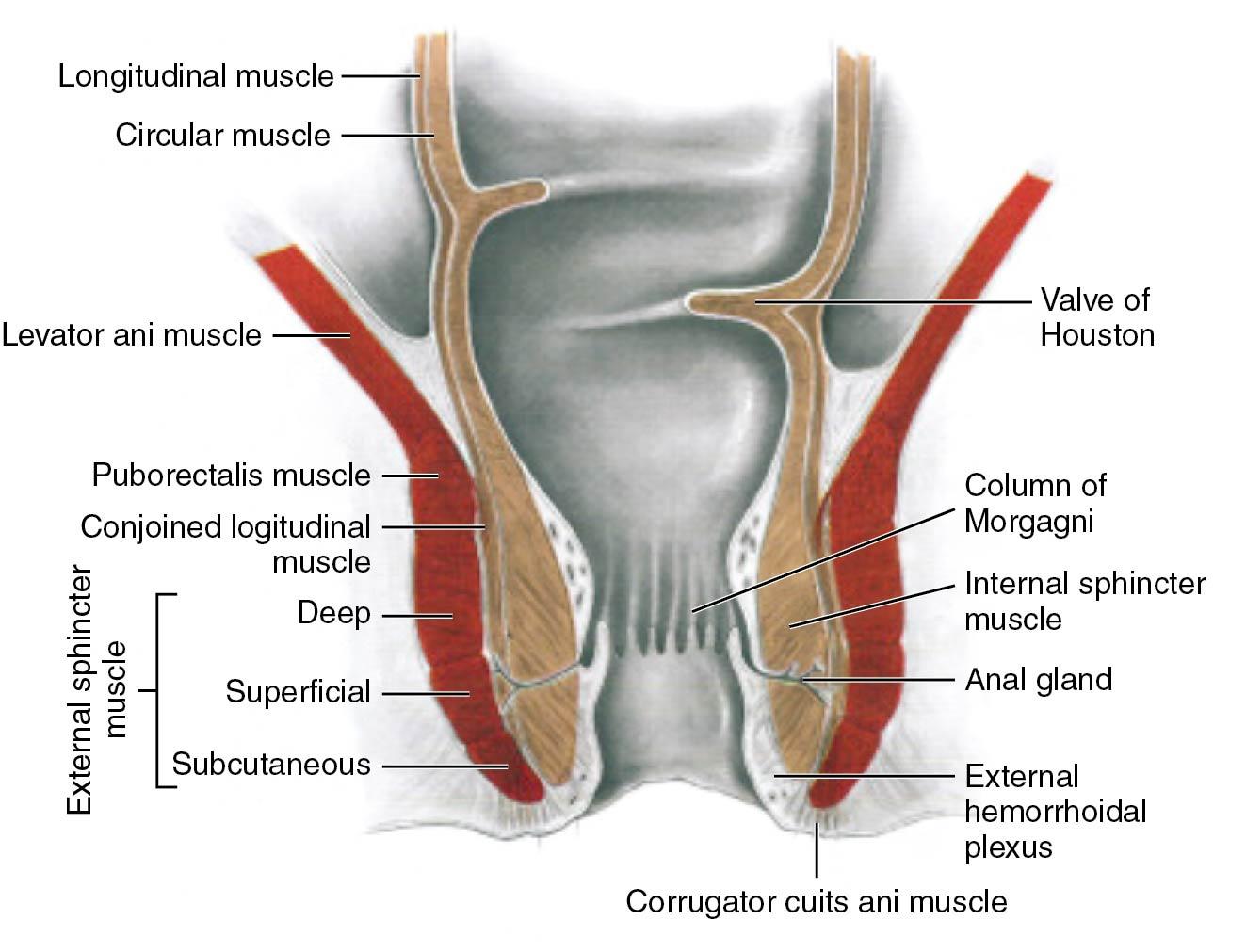
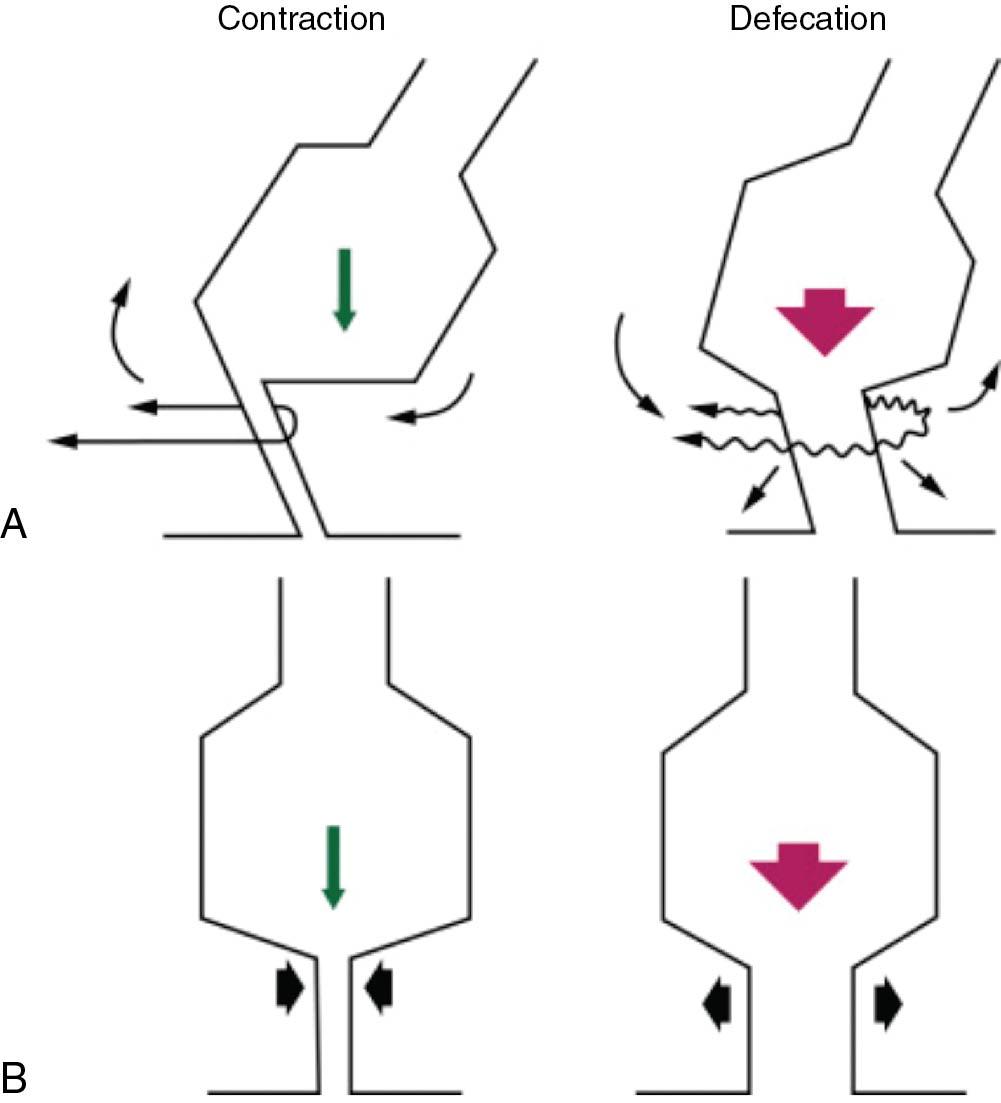
When a bolus of stool or gas is sensed in the rectum, the IAS reflexively relaxes, allowing for colonic contents to be sampled by the anal canal to distinguish solid, liquid, and gas forms of fecal material. This is known as the rectoanal inhibitory reflex (RAIR). After sampling, the IAS contracts and the fecal material is pushed back into the rectum. The RAIR can be inhibited by fecal impaction and chronic dilation of the anus, which can lead to incontinence, but if the impaction is cured, the reflex and anal tone can return to normal. The RAIR is also absent in women with Hirschsprung disease.
If the rectum has normal compliance and the person chooses to defer defecation, the IAS, EAS, and puborectalis remain contracted until the appropriate time to eliminate. Loss of any of these components can lead to incontinence of flatus, liquid, and/or solid stool.
Categorizing the many causes of FI ( Box 22.2 ) can be done by separating the initial cause into those that start outside the pelvis in a woman with a normal pelvic floor from those that start with an abnormal pelvic floor. Causes that start outside the pelvis include all the pathologic conditions that cause diarrhea or increased intestinal motility, overflow incontinence from fecal impaction, and rectal neoplasms. Known or diagnosable neurologic conditions such as multiple sclerosis, diabetic neuropathy, trauma, and neoplasms in the spinal cord or cauda equina initially begin as pathologic processes outside the pelvis, and the pelvic floor is presumed to be normal. As these neuropathies progress, typically there is damage to the pelvic floor musculature or rectal sensation, resulting in FI. People with diabetes, in particular, can develop autonomic neuropathy resulting in decreased IAS resting pressure, which can contribute to FI. Research on efferent brain-anorectal and spinoanorectal motor-evoked potentials identified the possibility that spinoanal and spinorectal neuropathy may play a role in the pathophysiology of FI.
Obstetric injury
Disruption of internal anal sphincter
Disruption of external anal sphincter
Pelvic floor denervation
Trauma
Pelvic fracture
Accidental injury
Anal intercourse
Anorectal surgery
Rectovaginal fistula
Diarrheal states
Irritable bowel syndrome
Infectious diarrhea
Inflammatory bowel disease
Short gut syndrome
Laxative abuse
Radiation
Malabsorption
Rectal neoplasia
Rectal prolapse
Rectocele
Hemorrhoids
Overflow
Impaction
Encopresis
Neurologic disease
Congenital anomalies (e.g., myelomeningocele)
Multiple sclerosis
Diabetic neuropathy
Neoplasms or injury of brain, spinal cord, cauda equina
Pudendal neuropathy (e.g., from childbirth, chronic straining, perineal descent)
Congenital anomalies of the anorectum or pelvis
FI secondary to an abnormal pelvic floor is caused by congenital anorectal malformations, surgery, obstetric injury, aging, or pelvic floor denervation without a known neurologic disease. FI secondary to denervation has typically been designated as idiopathic and is thought to represent more than 80% of patients. Pelvic floor nerve injury has been studied extensively in women with pelvic floor disorders. Denervation has been attributed to vaginal delivery, chronic straining with constipation, rectal prolapse, and descending perineal syndrome. In women with idiopathic FI, histologic studies of the EAS and puborectalis show fibrosis, scarring, and fiber-type grouping consistent with nerve damage and reinnervation. Pelvic floor electromyography (EMG) studies have also demonstrated increased fiber density consistent with reinnervation.
Injury to the anal sphincters at the time of vaginal delivery is the most common cause of FI in otherwise healthy women. Compared with spontaneous vaginal delivery, an operative vaginal delivery has consistently been associated with a significantly higher hazard of anal incontinence. A population-based survey of nearly 13,000 women in Norway identified that 1 in 4 women with a history of obstetric sphincter injury complained of anal incontinence as opposed to 1 in 6 in those who did not. During vaginal delivery, the EAS and/or the IAS can be disrupted, or stretching or crushing can injure the sphincter innervation. Sultan’s landmark study of normal spontaneous vaginal delivery showed by endoanal ultrasound that the incidence of occult EAS disruption ranged from 11% to 35%. This study found that 13% of primiparas and 23% of multiparas developed FI or fecal urgency by 6 weeks postpartum, and all but one of these women had evidence of anal sphincter disruption. Because anal sphincter injury correlated with the development of symptoms, reducing anal sphincter injury and understanding risk factors are critical to prevention. The first vaginal delivery appears to have the greatest effect on pelvic floor function and risk of EAS disruption, but subsequent deliveries can increase the risk of permanent damage, especially in women with transient symptoms of FI after their first delivery. Risk factors for anal sphincter injury include the following:
Midline episiotomy
Instrumented delivery
Vaginal delivery of larger infants
Persistent occiput posterior presenting head position
Older maternal age
For FI, even more than urinary incontinence, if the physician does not ask, women will typically not volunteer this information. Several reports have shown that twice as many women report fecal or flatal incontinence when given a written questionnaire rather than answering verbal questioning. A question such as “How often do you leak gas, liquid, or solid stool?” should be placed on standard office intake questionnaires. Of note, one study identified that women prefer the term accidental bowel leakage to fecal incontinence.
Because approximately 1 in 10 or more women will develop FI or fecal urgency after one vaginal delivery, it is important to incorporate open-ended questions concerning these problems as part of the 6-week postpartum visit. But the chance of developing FI also increases with age, so it is also important to target older women for questioning.
Assessment of the woman with FI must include a thorough history because the origin of the problem may be the single most important criterion of therapy. Box 22.3 lists some questions to consider when taking an FI history.
Onset and precipitating event(s)
Duration, severity, and timing
Stool consistency and urgency
Coexisting problems, surgery, urinary incontinence, back injury, diabetes or other neurologic problem
Medications contributing to diarrhea or constipation
Obstetric history—forceps, tears, presentation, repair
Drugs, caffeine, diet
Clinical subtypes—passive or fecal urge incontinence or fecal seepage
Possibility of impaction
Clinical grading of severity
History of pelvic surgery or radiation
The history should elicit the onset, duration, and severity of the condition; effect on the woman’s daily activities; pad use; frequency and consistency of bowel movements; use of laxatives; fiber intake; and dietary habits. Specific questions concerning diarrhea, amount of flatus, average number of stools per day, passage of mucus, and bloating should be asked. Physicians and patients can define normal bowel function differently. Diarrhea may mean frequent bowel movements to one person but loose and watery bowel movements to another. It is best to have the woman quantitate the number of bowel movements and incontinent episodes and describe the stool consistency. A diary of bowel habits and incontinent episodes can be useful, particularly in women who struggle to provide a clear history ( Fig. 22.3 ). In women who wear pads, these can be inspected to see if that represents her normal amount of leakage. Table 22.2 gives a commonly used scoring system developed by , although there are several other options to consider. The woman circles the appropriate number on each line of the scale. The sum of the lines indicates the severity of FI, with 0 indicating no incontinence and a score of 20 indicating complete incontinence. A score of 4 or more is typically considered significant. The value of this continence grading scale is that it can be used before and after treatment to determine the efficacy of the intervention. A standardized questionnaire should be used whenever possible to assess baseline FI severity and efficacy of treatment.
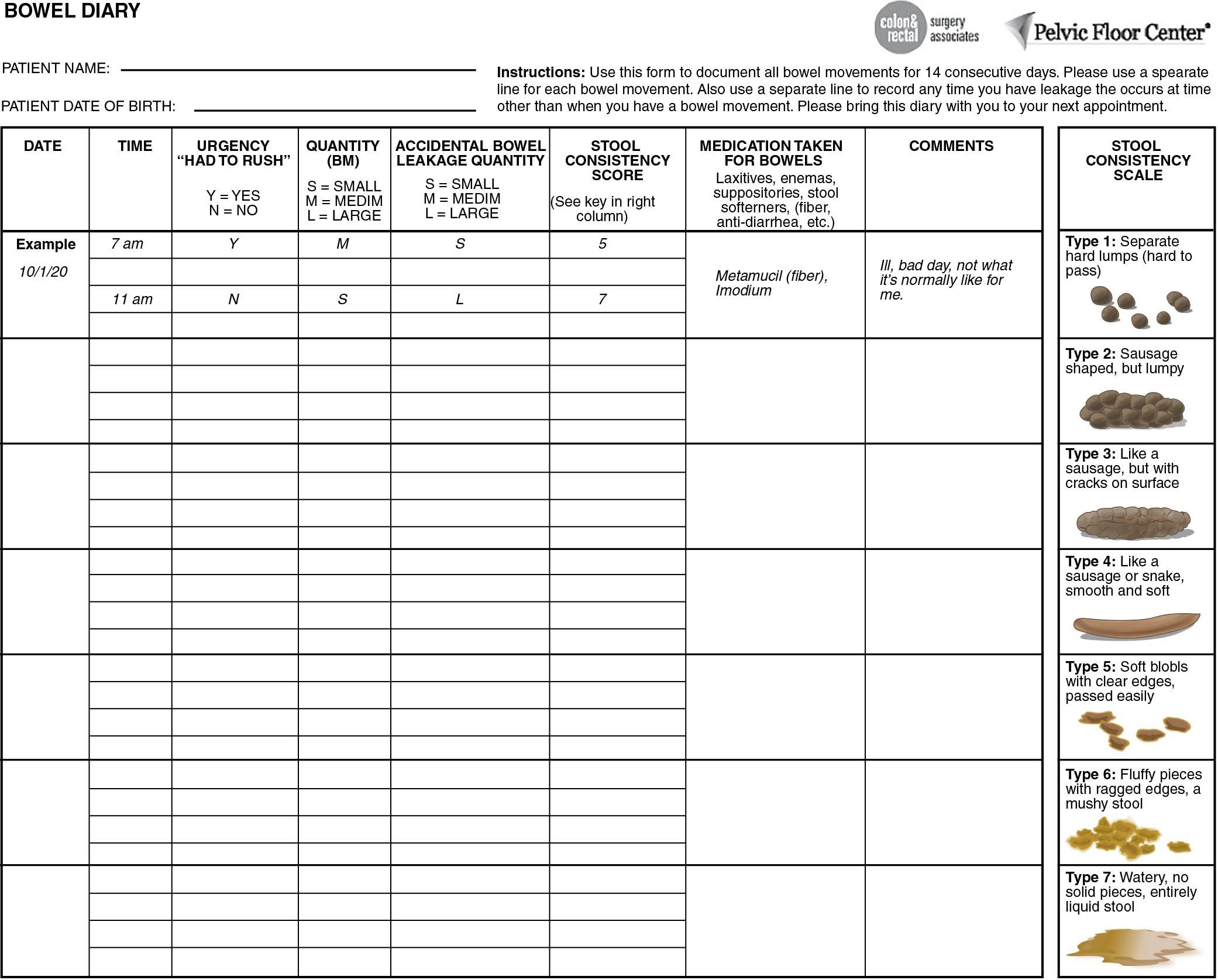
| Frequency | |||||
|---|---|---|---|---|---|
| Type of Incontinence | Never | Rarely | Sometimes | Usually | Always |
| Solid | 0 | 1 | 2 | 3 | 4 |
| Liquid | 0 | 1 | 2 | 3 | 4 |
| Gas | 0 | 1 | 2 | 3 | 4 |
| Wears pad | 0 | 1 | 2 | 3 | 4 |
| Lifestyle alteration | 0 | 1 | 2 | 3 | 4 |
* The continence score is determined by adding points from this table, which takes into account the type and frequency of incontinence and the extent to which it alters the patient’s life.
The history should identify complaints such as feelings of incomplete emptying, straining with bowel movements, fecal urgency, pain with defecation, and insensible loss of stool. It is particularly important to determine whether the woman has FI when she is aware of the need to defecate or if she is unaware and simply finds stool in her undergarments. When stool leakage occurs without warning, a sensory impairment or hygiene problem is implied, whereas if the woman is aware but cannot prevent the passage of stool, a motor impairment is more likely. Soiling may also be due to prolapsing hemorrhoids or rectovaginal or anovaginal fistulas.
Women should be questioned about other pelvic floor pathologic conditions, particularly rectal prolapse, rectovaginal fistulas, and urinary incontinence. Review of systems should include abdominal pain or cramping, lower back or pelvic pain, and changes in sexual response. Changes in pelvic or lower extremity neurologic function or acute onset of FI, in particular, should prompt evaluation for a neurologic disease, such as multiple sclerosis or a neoplasm of the brain or lumbosacral spinal cord.
The medical history is important to establish the state of the woman’s pelvic floor and anal sphincters. It should, when possible, include a detailed history of vaginal deliveries, including birthweights, length of second stage, episiotomies or lacerations, and use of forceps. Any breakdown or complications of episiotomy healing should be noted. Any history of abdominal or pelvic surgeries and/or trauma to the back or pelvis should be reviewed. The operative reports of any rectal or vaginal surgeries should be obtained and reviewed in particular for complications. The results of flexible sigmoidoscopies, colonoscopies, barium enemas, and defecography should be documented. Family history of colon cancer, inflammatory bowel disease, or familial polyposis should be elicited.
Many medications also affect bowel function ( Table 22.3 ). The woman should not only be asked about laxatives and bowel stimulants, but a complete list of all prescription and over-the-counter medications, as well as any dietary or herbal supplements, should be reviewed. Many drugs, including anticholinergics, antidepressants, iron, narcotics, nonsteroidal antiinflammatory drugs (NSAIDs), and pseudoephedrine, can cause chronic constipation that may contribute to overflow incontinence or pelvic floor neuropathy secondary to straining.
| Drug | Mechanism of Action |
|---|---|
| Nitrates, calcium channel blockers, beta-blockers, sildenafil, selective serotonin reuptake inhibitor | Reduce sphincter tone |
| Glyceryl trinitrate ointment, diltiazem gel, bethanechol cream, botulinum A toxin injection | Reduce sphincter tone via application of topical medications to the anus |
| Antibiotics, laxatives, metformin, orlistat, selective serotonin reuptake inhibitor, magnesium-containing antacids, digoxin, proton pump inhibitor | Cause loose stools or diarrhea |
| Benzodiazepines, selective serotonin reuptake inhibitor, antipsychotics | Relaxant, hypnotic |
The physical examination begins with inspection of the perineum and anal region. Pruritus ani, or discoloration and irritation of the perianal skin, is commonly seen with FI of liquid stool and chronic diarrhea. Perianal skin creases or folds should completely encircle the anus. Note the presence of protruding tissue around or from the anus and determine whether there are external hemorrhoids or mucosal or full-thickness rectal prolapse ( Fig. 22.4 ). The dovetail sign, or loss of anterior perineal folds, indicates a defect in the EAS or chronic third-degree laceration ( Fig. 22.5 ). Previous episiotomy, laceration, or surgical scars should be noted. The size of the genital hiatus and presence of genital prolapse should be assessed as an indicator of pelvic floor neuromuscular function. Eliciting the clitoral-anal or bulbocavernosus reflex can grossly test the innervation of the EAS. Using a cotton swab, a gentle, quick touch beside the clitoris or over the bulbocavernosus muscle should elicit a contraction of the EAS. If intact, the reflex implies that the pudendal afferent nerves and rectal or external hemorrhoidal branch of the pudendal efferent nerves are functional; however, 10% of women lack this reflex naturally. If absent in the presence of FI, though, further neurologic testing is suggested. Sensation in the S2-S4 dermatomes should be screened by dull and pinprick discrimination when touching the perineum. The same wooden cotton swab used to elicit bulbocavernosus reflexes can be broken and then used for pinprick (broken end) and dull (cotton end) sensation testing. Loss of sensation should direct the clinician to further neurologic or radiologic assessment of the nervous system.
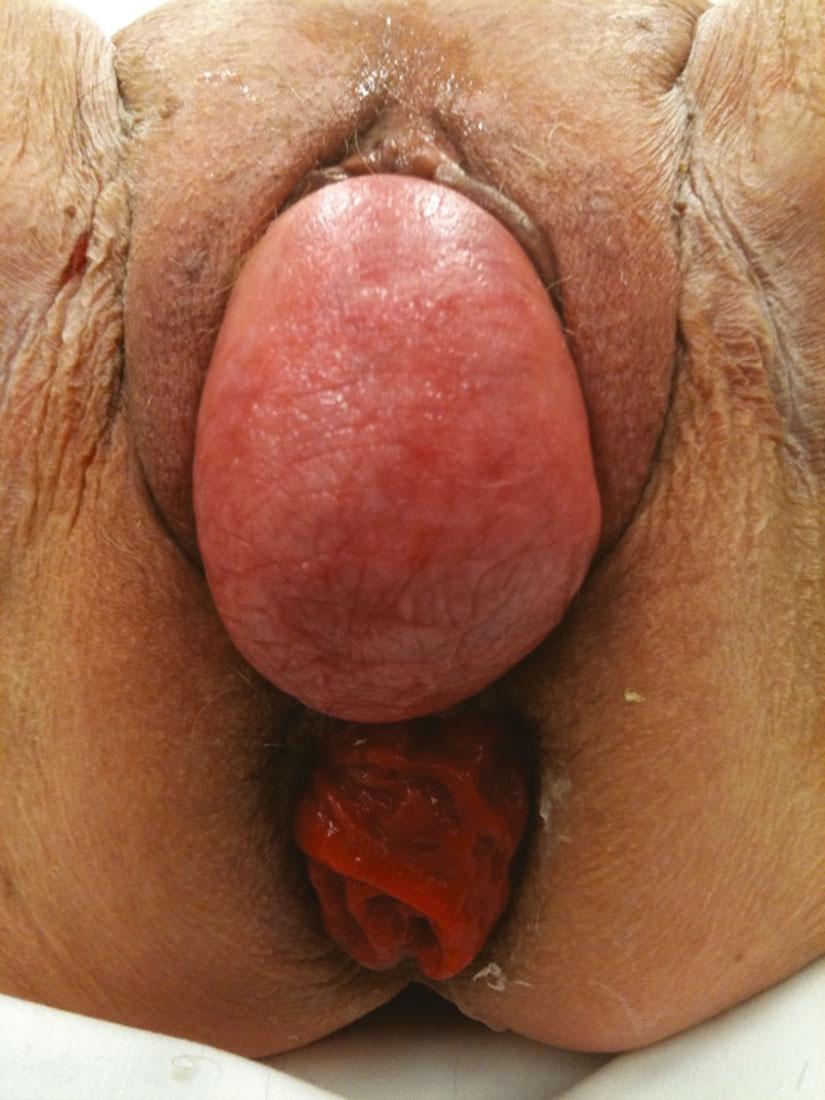
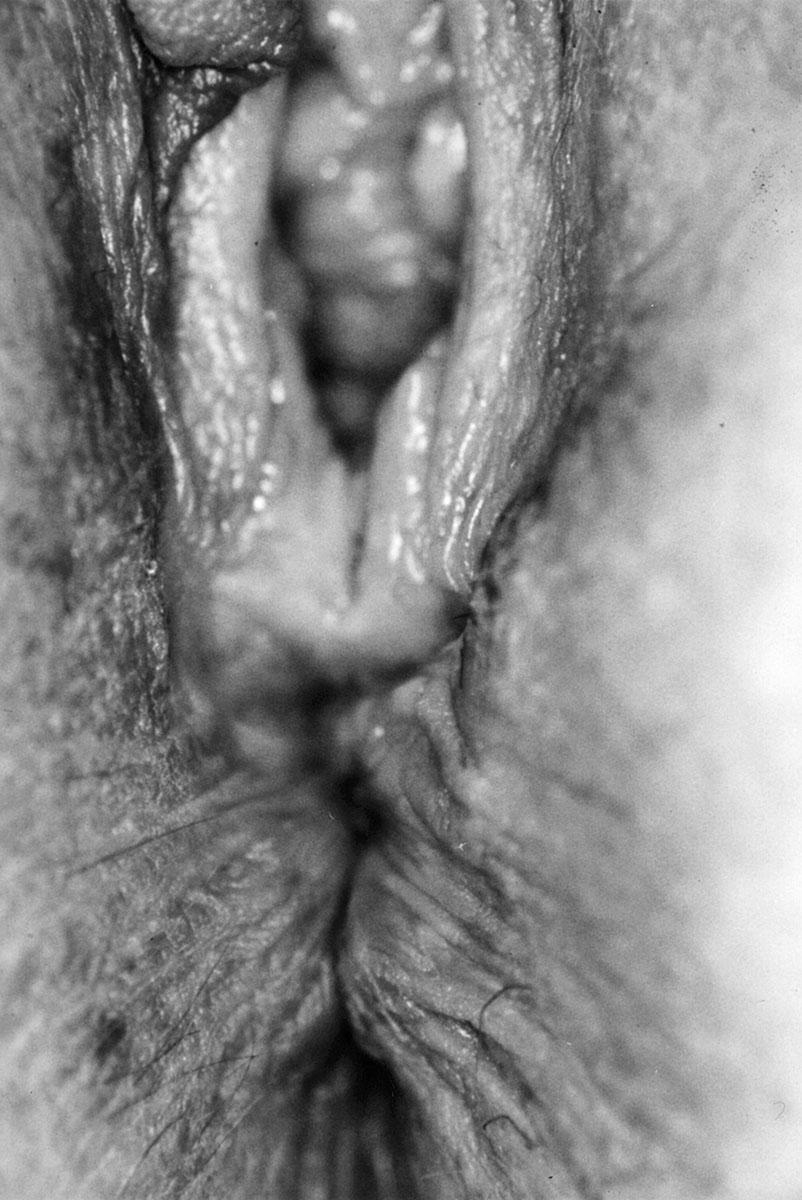
Next the woman should be asked to squeeze as if trying not to pass gas. The perianal folds should be evaluated for a concentric contraction and some upward movement of the perineal body as she contracts the EAS and levator ani; the patient should be instructed not to compensate by using contraction of the buttocks, upper thighs, or abdomen. The woman should then be asked to bear down as if trying to have a bowel movement. She should be reassured that it is expected that she might pass flatus during this part of the examination. The degree of perineal descent and any prolapse of the vagina, pelvic viscera, or rectum should be noted. If there appears to be any pelvic organ prolapse or if the degree or type of prolapse the woman complains of cannot be seen in the supine position, the examination should be performed with the woman in the standing position or after straining on a commode to maximize the prolapse.
Rectal examination is used to assess resting and squeeze tones of the anal canal. The resting tone of the anal canal is an indicator of IAS function. During squeezing of the EAS the examiner should feel circumferential contraction and tightening. An upward movement of the rectum and posterior compartment of the pelvis should be seen as the levator ani muscles contract. Because these muscles also play an important role in anal continence, evaluation of the levators for strength and symmetry should be performed by palpating the muscles on each side of the vagina at the introitus. Women with a history of vaginal delivery will often have a noticeable asymmetry because this portion of the levator is the most commonly injured. While doing the rectal examination, the presence of a rectocele, enterocele, rectal prolapse, or bowel intussusception should also be assessed as the woman strains. With a finger in the rectum and another in the vagina, the integrity of the rectovaginal septum, posterior vaginal wall, and perineal body can also be evaluated.
The anal canal and rectum should also be palpated for masses, a dilated rectum, and the presence of stool in the rectal vault. As noted earlier, a rectum chronically distended with stool, a tumor, or an intussuscepting bowel will disrupt the RAIR. If this reflex is suppressed, the anal canal remains dilated, the EAS fatigues, and incontinence can occur.
Clinical diagnosis based on physical examination and history alone will be sufficient in most women; however, a prospective study at a tertiary colorectal referral clinic found that further evaluation, including radiologic and physiologic tests, altered the final FI diagnosis in 19% of cases. The algorithm outlined in Fig. 22.6 recommends further evaluation based on history and the rectal tone. Normal rectal tone directs the clinician away from anal incontinence and toward a metabolic or colonic origin. Common metabolic tests include thyroid-stimulating hormone and glucose levels. If chronic diarrhea is present with normal rectal sphincter tone, stool cultures, colonoscopy, and diarrhea evaluation are suggested. The differential diagnosis for a diarrhea workup includes the following:
Lactose intolerance
Celiac sprue
Inflammatory bowel disease
Irritable bowel syndrome
Bacterial overgrowth from diabetic gastroparesis
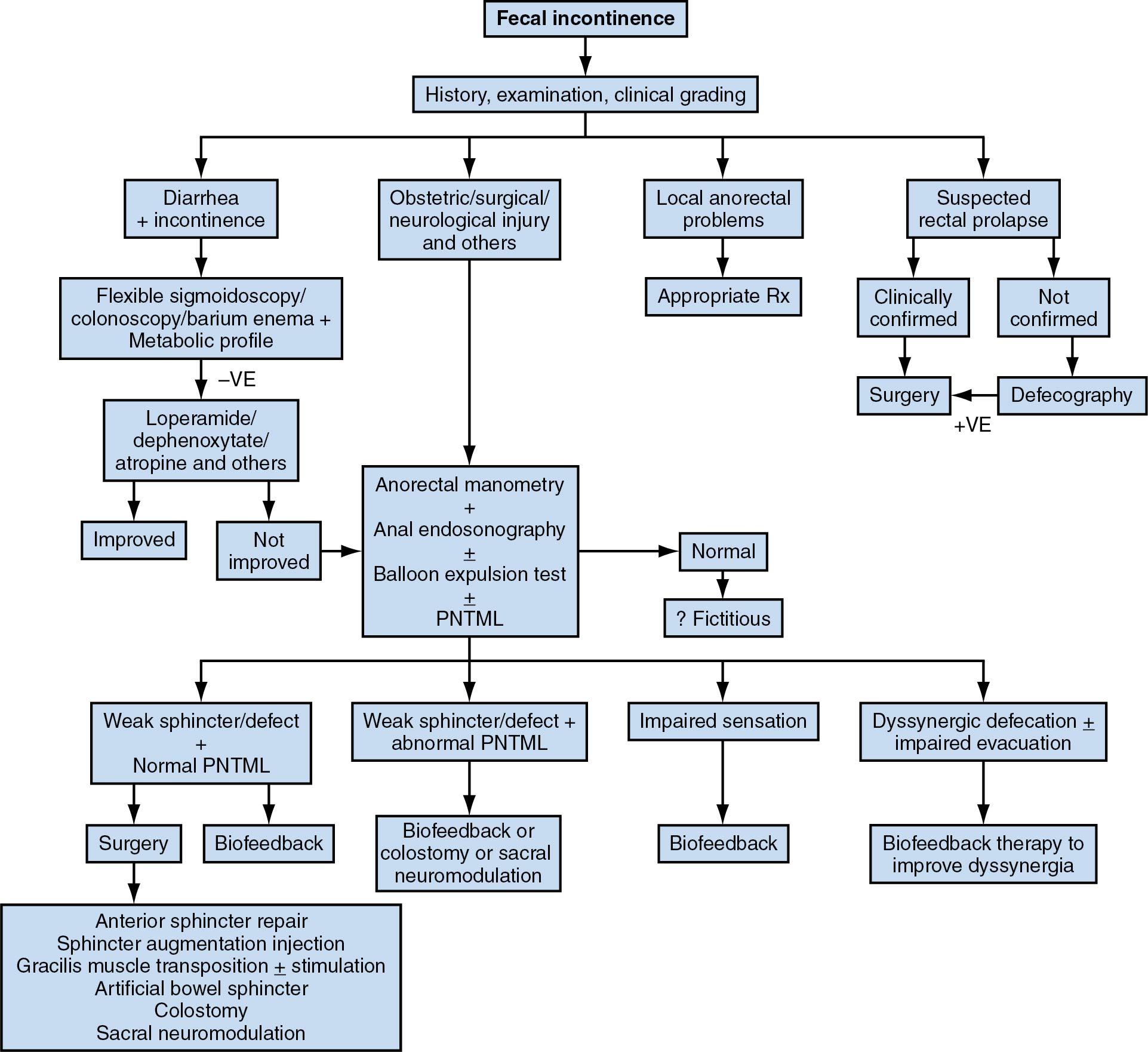
In cases of FI with normal rectal sphincter tone without diarrhea, anal manometry to evaluate rectal sensation may be useful to assess for peripheral neuropathy causes.
Poor resting tone on rectal examination directs the clinician to a neuromuscular cause. A normal resting tone, but with poor squeeze, suggests an anterior sphincter defect and chronic third-degree laceration of the EAS. If poor rectal squeeze is detected, endoanal ultrasonography is the considered the best method to assess for a disrupted EAS.
Evaluation or further testing is performed not only for diagnostic purposes but also to determine which nonsurgical and surgical therapies are most likely to benefit the woman. Whenever the woman’s history does not match her physical examination findings, further testing should be considered. In addition, if the woman has had prior surgery or has other pelvic floor dysfunction, testing before treatment, especially surgical, may help clarify the optimal care plan. It is important to remember that the woman may have more than one pathologic process contributing to her FI, such as pudendal neuropathy and an anal sphincter defect in combination with a weakened pelvic floor and diarrheal state ( Table 22.4 ).
| Test | Measures | Indication | ASCRS Recommendation |
|---|---|---|---|
| Anal manometry |
|
|
Can be considered to help define the elements of dysfunction and guide management. Strong recommendation based on low- or very-low-quality evidence, 1C |
| Single-fiber EMG |
|
|
No recommendation |
| Pudendal nerve motor latency | Speed of signal along pudendal nerve | Pudendal nerve damage from childbirth or straining | May be performed but has limited impact in the diagnosis and management of patients with FI, and is not routinely recommended. Strong recommendation based on moderate-quality evidence,1B |
| Endoscopic ultrasound | IAS and EAS defect | Obstetric or traumatic sphincter injuries | Useful to confirm sphincter defects in patients with suspected sphincter injury. Strong recommendation based on moderate-quality evidence, 1B |
| Defecating proctography or MRI defecography |
|
|
A colonoscopy is indicated for any woman with chronic diarrhea to evaluate for inflammatory bowel disease or infectious diarrhea. It is also appropriate screening for any woman older than 50 years, particularly if an acute change in bowel habits is reported. Endoscopic evaluation detects mucosal disease or neoplasia effectively. In addition, any woman presenting with FI in the setting of rectal prolapse should undergo a colonoscopy to ensure that a rectal mass is not the cause of the prolapse.
Endoanal ultrasound (EAUS) has significantly enhanced the ability to delineate defects of the IAS and EAS. It is one of the simplest and least expensive tests for imaging sphincter defects; however, it is user dependent and requires significant training. EAUS is generally performed with a 10-MHz rigid probe that creates a 360-degree circular image of the anal sphincter complex, allowing assessment of the integrity, thickness, and length of the anal sphincter complex. The IAS is visible as a hypoechoic circle, and the EAS is seen as a hyperechoic or mixed echogenic circle ( Fig. 22.7 ). The distal anal canal is characterized by the presence of the EAS but a thin or absent IAS. In the mid–anal canal the IAS and EAS are both robust, whereas the proximal anal canal is characterized by the posterior sling of the puborectalis. EAUS can also be used to determine the size of the perineal body by using a gloved finger inserted into the vagina to oppose the rectovaginal septum against the probe.

EAUS is most useful in the evaluation of women with chronic third-degree lacerations or for suspicion of occult sphincter tears ( Fig. 22.8 ). Knowing the boundaries of the sphincter defect and whether both the EAS and IAS are disrupted can direct the surgeon at the time of anal sphincteroplasty if that is indicated.
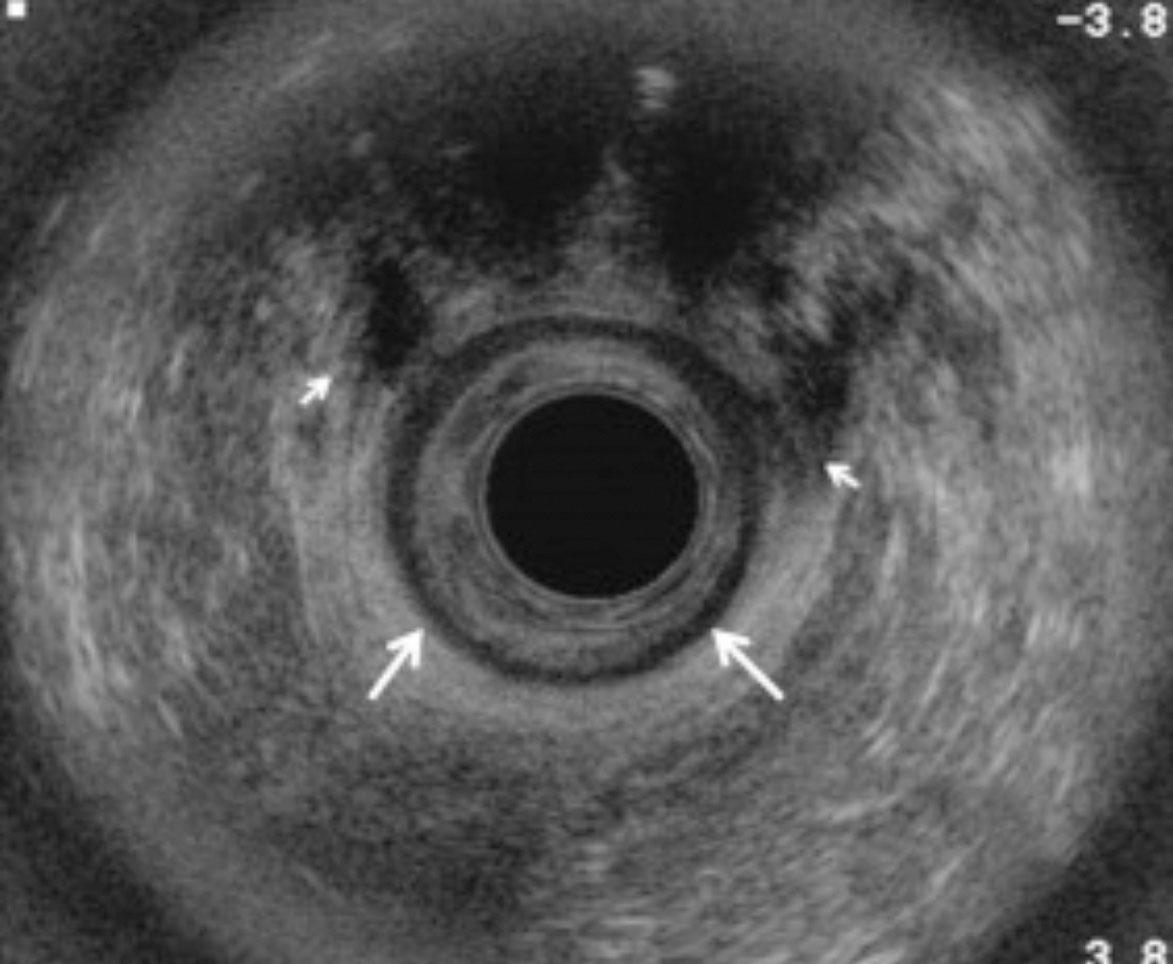
Become a Clinical Tree membership for Full access and enjoy Unlimited articles
If you are a member. Log in here